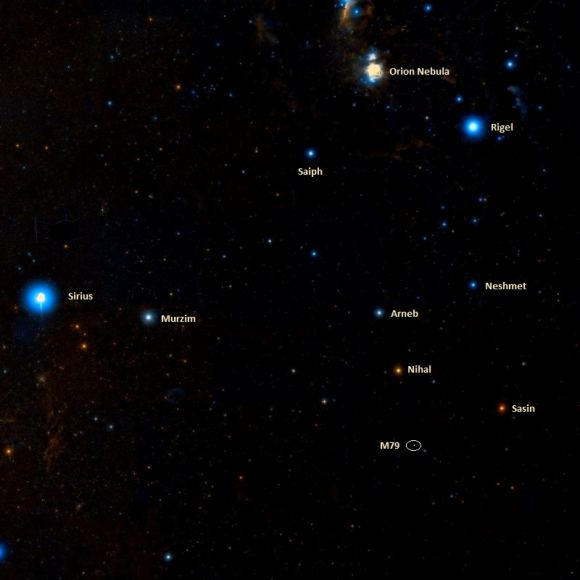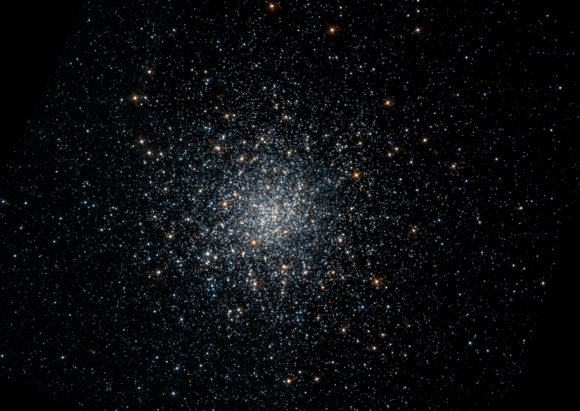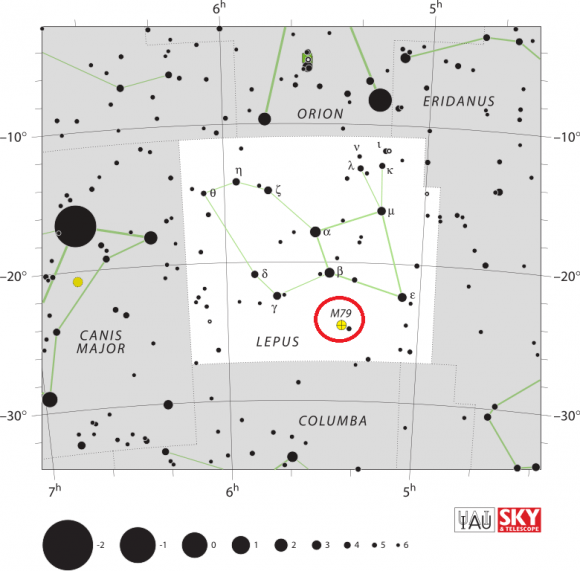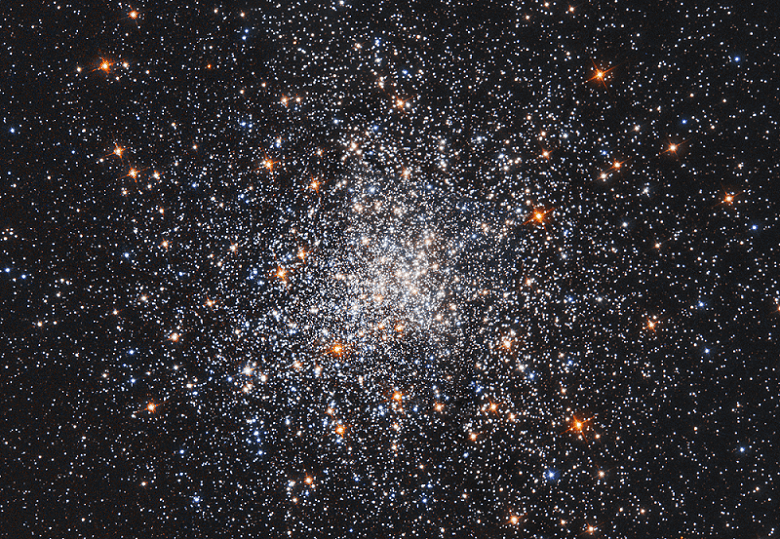Welcome back to Messier Monday! Today, we continue in our tribute to our dear friend, Tammy Plotner, by looking at the globular cluster known as Messier 79!
During the 18th century, famed French astronomer Charles Messier noticed the presence of several “nebulous objects” while surveying the night sky. Originally mistaking these objects for comets, he began to catalog them so that others would not make the same mistake. Today, the resulting list (known as the Messier Catalog) includes over 100 objects and is one of the most influential catalogs of Deep Space Objects.
One of these objects is Messier 79 (aka. NGC 1904), a globular cluster in the constellation Lepus. Located about 42,000 light years from Earth, and 60,000 light years from the Galactic Center, this cluster is believed to not be native to the Milky Way itself. One possibility is that it arrived in our galaxy as part of the Canis Major Dwarf Galaxy, which is currently the closest galaxy to our own (though this remains the subject of debate).
Description:
Do you need an unusual globular cluster to add to your observing list? Then here’s one for you. Located over 42,000 light years from us, but about 60,000 light years from the galactic center, Messier should rightfully be around the Galactic center, but has somehow ended up in the other hemisphere instead – appearing to be at home in the central stellar bulge of our Milky Way galaxy.

How did this 118 light year diameter ball of stars that’s moving away from us at 200 kilometers per second come to be where it is at? There may be a chance that it was integrated from a galaxy that we’ve cannibalized – such as a remnant globular cluster system of the Canis Major Dwarf galaxy – or M78 could even be a dwarf spheroidal galaxy currently experiencing a very close encounter! As B. Lanzoni (et al) found in their 2007 study:
“By combining high-resolution and wide-field ground based and space observations, we have collected a multi-wavelength photometric data base (ranging from the far UV to the near infrared) of the galactic globular cluster NGC1904 (M79). The sample covers the entire cluster extension, from the very central regions up to the tidal radius. In the present paper such a data set is used to study the BSS population and its radial distribution. A total number of 39 bright (m218 ? 19.5) BSS has been detected, and they have been found to be highly segregated in the cluster core. No significant upturn in the BSS frequency has been observed in the outskirts of NGC 1904, in contrast to other clusters (M 3, 47 Tuc, NGC 6752, M 5) studied with the same technique. Such evidences, coupled with the large radius of avoidance estimated for NGC 1904, indicate that the vast majority of the cluster heavy stars (binaries) has already sunk to the core. Accordingly, extensive dynamical simulations suggest that BSS formed by mass transfer activity in primordial binaries evolving in isolation in the cluster outskirts represent only a negligible (0–10%) fraction of the overall population.”
BSS… Blue Straggler Stars, huh? Just what causes that? According to F.R. Ferraro and his 2008 study:
“Ultra-dense cores of Galactic Globular Clusters (GCs) are very efficient ”furnaces” for generating exotic objects, such as low-mass X-ray binaries, cataclysmic variables, millisecond pulsars (MSP), blue stragglers (BSS), etc. Most of these stars are thought to be the by-products of the evolution of binary systems, possibly originated and/or hardened by stellar interactions. Thus, studying the nature of these exotic objects and the properties of artificial sequences, as that of BSS, in the color magnitude diagrams (CMDs) of GCs can serve as a powerful diagnostic of the dynamical evolution of clusters, and of its effects on the evolution of their stellar population and binary systems. Recent high-resolution observations of the central region of Galactic globular clusters have shown the presence of a large variety of exotic stellar objects whose formation and evolution may be strongly affected by dynamical interactions. The existence of such a population has been a puzzle for many years, and even now its formation mechanism is not completely understood, yet. At present, the leading explanations involve mass transfer between binary companions, the merger of a binary star system or the collision of stars (whether or not in a binary system). Direct measurements and indirect evidence show that BSS are more massive than the normal MS stars, pointing again towards collision or merger of stars.”

History of Observation:
Chances are, Pierre Mechain didn’t know the stars inside this tight globular cluster were crashing into each other when he discovered it on the night of October 26, 1780. Nor did Charles Messier notice anything amiss when he logged it on December 17 of the same year:
“Nebula without star, situated below Lepus, and on the same parallel as a star of sixth magnitude: seen by M. Mechain on October 26, 1780. M. Messier looked for it on the following December 17: this nebula is beautiful; the center brilliant, the nebulosity a little diffuse; its position was determined from the star Epsilon Leporis, of fourth magnitude.”
On January 13, 1806, Sir William Herschel would be the first to shatter M78 into stars. In his private notes he writes:
“The 79th of the Connoiss. is a cluster of stars of a globular construction, and certainly extremely rich. Towards the centre the stars are extremely compressed, and even a good way from it. With 171 the diameter is a little less than 1/3 of the field, and with 220 a little more; the field of one being 9’0″, and of the other 8’0″, a mean of both gives the diameter of the cluster 2’50”, but I suppose that the lowness of the situation prevents my seeing the tiny scattered stars, so that this cluster is probably larger than it appears.”
Locating Messier 79:
M79 isn’t hard to find once you’ve identified the four primary stars of Lepus which resemble a lopsided rectangle. Next step? Located Gamma and Beta. You will know both of these stars if you check them in binoculars (or have very good eyes and sky conditions) because they will have an optical companion. Your starting point is Beta Lepus and from there look approximately 4 degrees (3 finger widths) south for 5.5 magnitude ADS 3954. This star will show easily in binoculars and reveal itself as a nice binary in a telescope.

M79 is 1/2 a degree northeast of ADS 3954 and will show in the same binocular field as almost an “echo star” reflection. At low magnification, the two can appear in the same eyepiece field of the telescope as well. It will be a comet-like, small fuzzy for small aperture, take on a grainy texture in a mid-sized telescope and resolved wonderfully to large instruments. Messier 79 stands up very well to urban skies and to a certain amount of moonlight.
May you enjoy your observations!
And here are the quick facts on this Messier Object to help you get started:
Object Name: Messier 79
Alternative Designations: M79, NGC 1904
Object Type: Class V Globular Cluster
Constellation: Lepus
Right Ascension: 05 : 24.5 (h:m)
Declination: -24 : 33 (deg:m)
Distance: 42.1 (kly)
Visual Brightness: 7.7 (mag)
Apparent Dimension: 9.6 (arc min)
We have written many interesting articles about Messier Objects and globular clusters here at Universe Today. Here’s Tammy Plotner’s Introduction to the Messier Objects, M1 – The Crab Nebula, Observing Spotlight – Whatever Happened to Messier 71?, and David Dickison’s articles on the 2013 and 2014 Messier Marathons.
Be sure to check out our complete Messier Catalog. And for more information, check out the SEDS Messier Database.
Sources:

